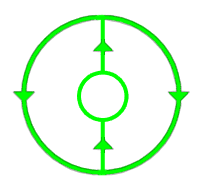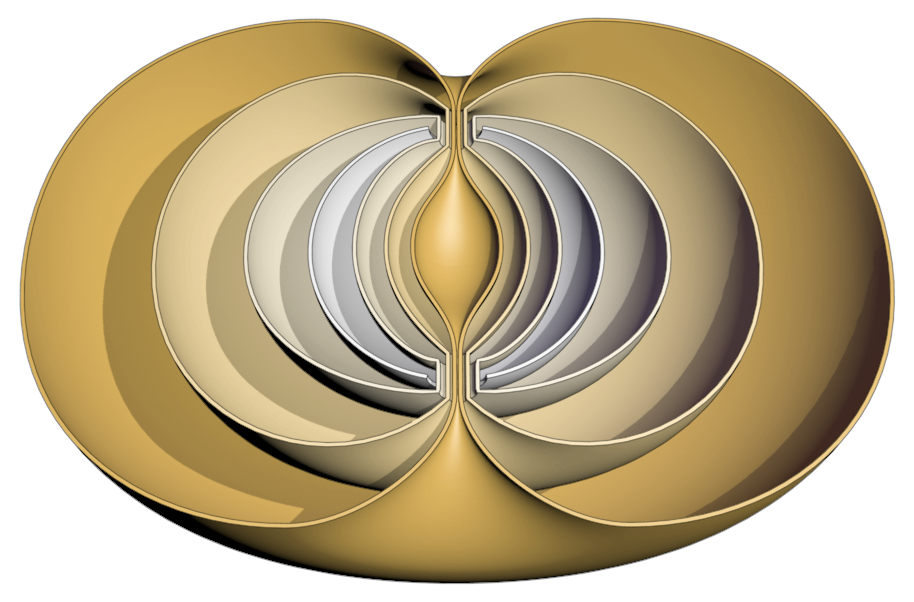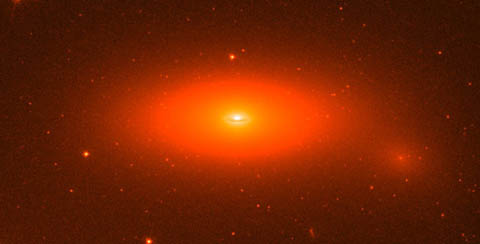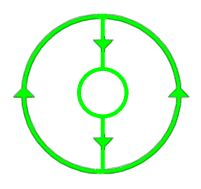The Suprabells

We've discussed the first half-cycle and the third half-cycle of the transformation sequence. Both these half-cycles are outward dimensional (uneven number). The first half-cycle was about the ladders and the spirals, the second half-cycle was about the bells and the magnetic fields. This page is about the fifth half-cycle, this is the part of the transformation sequence inhabited by the suprabells.
The fifth half-cycle is the domain of the superfluids and high vacuums. The state of equilibrium for superfluids and high vacuums are vortices that are located in this half-cycle.
The higher dimensional a vortex is, the less visible that vortex is and the less tangible it is. That is why the higher dimensional a vortex is, the less likely it is for us to find clues for the existence of this vortex. So the first half-cycle is the part of the sequence of which we find the most clues for all the characteristics of those vortices in the shortest period of time. We know the entire shape of the first half-cycle reasonably well, not in complete accuracy, but reasonably close to that. For the third half-cycle we find less clues within the same period of time, and for the fifth half-cycle we need to look even harder.

The image above shows how part of the fifth half-cycle looks like. These are all high dimensional vortices with a thin outer layer and a shape that is very expanded outwards. The geometry of this part of the sequence takes in the shape of a magnetic field. It could be that the empty space between the stages of this half-cycle is also occupied by vortices, there could be vortices of a different type that fill in the gaps. Perhaps an electric or magnetic field is what occupies the empty space.
The different stages of the vortices all show the same basic sum movement, that includes an inner part, a movement along one vertical axis, followed by a outer shell, then looping back to a vertical axis. Every different suprabell in the sequence makes this same basic movement yet at a progressively higher dimensional state.
I cannot describe these vortices in greater detail, for there is too little information I have about them to write a page about the suprabell in the same manner as I have done with the previous pages. I can however give you a few examples of observations of suprabells. The first two of such examples are water bells.
Liquid Impact Bell
The photo and video below shows a liquid bell that forms when a jet of water impacts on a reversed cone or little spoon. Quite amazing isn't it? To see such a shape bend inward again and fully close itself. Not quite what you would expect. The water bell is held together by surface tension. The jet of water forms the axis of the suprabell, the visible water bell forms the inner part of the suprabell.
movie © C.Clanet, Marseille (IRPHE), converted from Quicktime
Water Bell Fountain
 Image © Crystal Fountains TM |
 |
This is another type of bell that that some people have in their garden pool. You can make one with a nozzle that is especially designed to do that job. The jet of water that runs through the pipe is the central axis of the suprabell, the visible water bell forms the outer part of the suprabell. The shape of this vortex, together with the central pipe, looks like a jellyfish.
Hints found in Fruits

The best way you can learn about how the precise shape of each vortex looks like is by looking at fruit. In fruits you can see what the most likely shape of the inner part is that belongs to the shape of the outer part. Particularly the curvature of the geometrical shape. Not particularly the ratio of width to height. The width and height can vary between different fruits that show the same level of curvature. The more expanded the outer part looks, the less expanded the inner part looks.
_Edited_UnderCCBYSA3.0.jpg) |
_Edited_UnderCCBY2.0.jpg) |
_Edited_UnderCCBYSA3.0.jpg) |
In these three images above, the left image is from Genet, under the CC BY-SA 3.0 license. Middle image is from Liz West, under the CC BY 2.0 license. Image on the right is from J.Smith, under the CC BY-SA 3.0 license. All three images were taken from Wikimedia and all three images have been edited by removed of background, adding of glow to edges and some images were rotated.
I must clearly state that the body of these fruits are not suprabells, only the thin outer skin of these fruits, combined with a thin inner layer of these fruits are suprabells. What exactly for vortex movement the fillings in between these layers are is not yet known. Not only do these shapes appear in plant life, they also appear in organic life as well.
Superfluids
 Image by John.F.Allen |
Superfluidity is also mentioned on the page about state of equilibrium. When helium-4 is cooled close to absolute zero (2.17 Kelvin), a remarkable change in the properties of the liquid occurs, and the liquid starts behaving like a fluid with zero viscosity and zero entropy. The substance, which still looks like a normal fluid, will flow without friction past any surface, which allows it to remain motionless when its container is rotated, circulate over obstructions and even defy the laws of gravity.
An important application of liquid helium has been in the study of superconductivity and for the applications of superconducting magnets.
The state of equilibrium of a superfluid is a suprabell. This is best shown by the fountain effect, in which a superfluid forms a continues frictionless fountain that flows forever by only adding a low heat source. Studying superfluids requires understanding its link to suprabells.
Lenticular Galaxies
Some lenticular galaxies might be suprabells as well. Yet it is not certain. Below are two images of galaxies that might be suprabells. In these galaxies you can see a voluminous ellipsoidal shape with a clear distinction between an inner part and an outer part, which both differ significantly in density. These are both images that are captured in low detail, which could be a factor that conceals the true identity of these galaxies. These might be suprabells, or they might not be.
| NGC3115 | NGC1277 |
AndNASAAndNSF_PublicDomain.jpg) Image by 2MASS / Umass / IPAC-Caltech / NASA / NSF |
 Image by NASA/ESA/Andrew C. Fabian |
The outer space medium is a high vacuum, and the state of equilibrium for high vacuums are the suprabells. So if you quickly run to conclusions you might say that a suprabell can not appear within the outer space medium. But the thing is that there are several types of suprabells, and only one of them can be the state of equilibrium for any given location in the outer space medium. And another important detail that should not be overlooked is that the vacuum accounts for the state of equilibrium at mesocyclic scale, thus at a relatively small scale level. At a macrocyclic scale the state of equilibrium for the outer space medium is the revolute, not a suprabell. These galaxies are macrocyclic in size, thus they can not be revolutes, yet they can very well be suprabells.
| All content on this site that is authored by Peter.A.Venis is licensed under the Creative Commons CC BY 4.0 license, unless otherwise mentioned. Most pages on this website also include material from other authors, under different licenses. Both the author's names and the licenses are mentioned in the file names whenever this information is known and can be provided. The presence of work from other authors on this website does not necessarily imply that those authors endorse the contents of this website. |
| A word that is often used on this website is the word 'vortex'. Many sources describe a vortex as a movement in a fluid that has a rotational flow. Yet many of the vortices that I describe on this website do not show a visible rotational flow. I took the liberty of using the word vortex for describing a phenomenon that had not been understood before, one that links together rotational and non-rotational movements. Even a movement in a straight line can in some cases be categorized as a vortex, if it is known that that movement is created by certain identical conditions. So keep in mind that the word 'vortex', within the context of the infinity-theory, has not the exact same meaning as other sources describe. |





